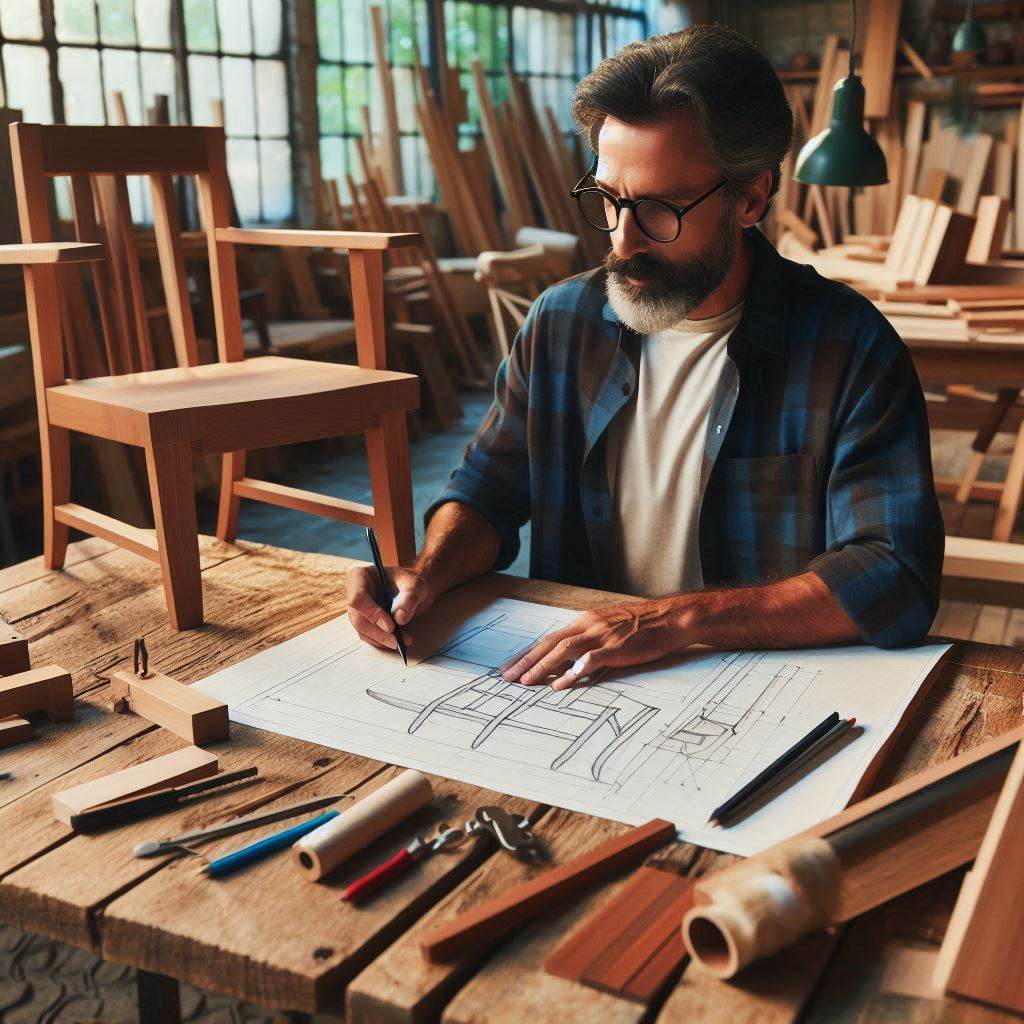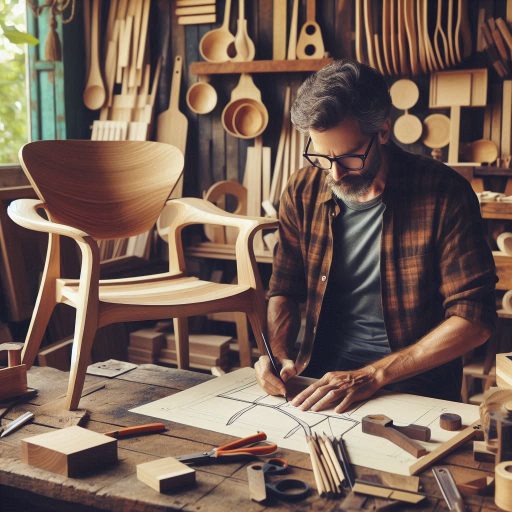Introduction
Creating a furniture design portfolio is essential for any designer.
It serves as your visual resume, showcasing your unique style and skills.
In today‘s competitive market, a strong portfolio sets you apart from others.
Clients and employers want to see tangible evidence of your abilities.
A well-crafted portfolio provides that evidence in a compelling way.
Your portfolio highlights your design process and creativity.
It allows you to demonstrate how you approach each project.
When you include various pieces, you showcase your versatility.
This variety appeals to a wider range of clients or employers.
They appreciate seeing a breadth of work rather than just one style.
A furniture design portfolio also illustrates your problem-solving skills.
Each project often presents its own challenges.
By showcasing your solutions, you reveal your ability to think critically.
Potential clients want to know how you tackle issues during the design process.
A strong portfolio communicates that you can handle diverse challenges.
Furthermore, your portfolio reflects your experience.
It documents your journey as a designer, including your growth.
As you gain experience, your portfolio should evolve.
This evolution shows potential clients that you are continuously improving your craft.
It demonstrates commitment and dedication to your profession.
Determine your target audience
Creating a successful furniture design portfolio begins with knowing your target audience.
Identifying the type of clients or employers you want to attract is crucial.
Are you aiming for residential clients, commercial businesses, or interior designers? Each audience has unique needs and expectations.
Identify the Type of Clients or Employers You Want to Attract with Your Portfolio
Once you understand your audience, you can tailor your portfolio accordingly.
Research your target market to grasp their preferences and trends.
This knowledge allows you to highlight relevant projects and designs that resonate with them.
For example, if your audience includes modern home buyers, showcase sleek, minimalist designs.
Conversely, if you target traditional clients, emphasize classic styles and craftsmanship.
Tailor Your Portfolio to Meet the Specific Needs and Preferences of Your Target Audience
Your portfolio should reflect the specific needs of your audience.
If you aim to attract high-end clients, include luxurious materials and intricate details.
Showcase your best work and demonstrate your versatility.
Highlight projects that align with the styles your audience admires.
If you want to appeal to eco-conscious clients, focus on sustainable materials and practices.
Consider the presentation of your portfolio as well.
Use high-quality images that capture the essence of your designs.
Clear, professional photographs make a strong impression.
Ensure that each image conveys your design philosophy and style.
Avoid clutter and distractions; simplicity enhances your message.
In addition to visuals, include project descriptions that speak to your audience.
Briefly explain the inspiration behind each piece.
Highlight the materials used and the design process.
This narrative helps potential clients connect with your work on a deeper level.
It also showcases your ability to communicate effectively.
Remember to keep your portfolio updated.
As you gain experience and complete new projects, add them to your portfolio.
This practice keeps your work fresh and relevant.
Regular updates reflect your growth as a designer and show your commitment to your craft.
Seek feedback from peers or mentors about your portfolio.
Constructive criticism can help you refine your focus and improve your presentation.
Incorporate their suggestions to better align your portfolio with your target audience’s expectations.
Finally, remember that your portfolio is a marketing tool.
Use it to tell your story and express your design philosophy.
A well-crafted portfolio not only showcases your skills but also resonates with potential clients.
By clearly defining your target audience and tailoring your work to their needs, you can create a compelling portfolio that attracts the right opportunities.
Select Your Best Work
Creating a furniture design portfolio requires careful selection of your best work.
This step is crucial in showcasing your skills and personal style.
Start by choosing a variety of projects.
Diversity in your portfolio will demonstrate your versatility as a designer.
Select pieces that highlight different design elements and approaches.
This variety will engage potential clients and employers.
Choose a Variety of Projects That Highlight Your Design Skills and Style
Include projects that reflect your design philosophy.
Choose pieces that not only impress but also tell a story.
For example, consider showcasing a project that solves a common problem.
This demonstrates your ability to think critically about design challenges.
Include a Mix of Sketches, Renderings, and Completed Projects to Showcase Your Range and Versatility
Incorporate a mix of sketches, renderings, and completed projects.
Sketches reveal your initial ideas and creativity.
They show your thought process and how you develop concepts.
Including sketches can also highlight your hand-drawing skills, which many clients appreciate.
Renderings allow you to showcase your ability to visualize designs.
High-quality renderings can bring your ideas to life, making them more tangible.
Use software tools to create stunning 3D renderings that capture attention.
Make sure these renderings are clear and professionally presented.
Showcasing completed projects is essential.
Clients want to see the final result of your design efforts.
Include high-quality photographs of your finished furniture pieces.
These images should be well-lit and taken from various angles.
This presentation will highlight the craftsmanship and details of your work.
Consider presenting a cohesive theme in your selection.
A consistent style can enhance your portfolio‘s overall appeal.
However, don‘t be afraid to include contrasting styles.
This contrast can demonstrate your ability to adapt to different design contexts.
Keep your audience in mind when selecting your work.
Consider what potential clients or employers are looking for in a designer.
Aim to include projects relevant to your desired niche in the furniture industry.
This relevance will strengthen your portfolio‘s impact.
Regularly update your portfolio as you complete new projects.
Remove older work that no longer represents your current skills or style.
A fresh portfolio will reflect your growth and evolving design sensibilities.
In short, carefully selecting your best work is vital for creating an effective furniture design portfolio.
A diverse mix of sketches, renderings, and completed projects will showcase your range and versatility.
This selection will position you favorably in the competitive furniture design market.
Read: Top Skills Needed for Art Educators and Instructors
Organize Your Portfolio
Creating a well-organized furniture design portfolio can significantly enhance your presentation.
A cohesive and visually appealing layout captures the viewer‘s attention immediately.
It sets the tone for how your work will be perceived.
Follow these steps to organize your portfolio effectively.
Create a Cohesive and Visually Appealing Layout for Your Portfolio
First, choose a consistent design theme for your portfolio.
Use similar fonts, colors, and graphics throughout.
This consistency creates a professional look and helps unify your work.
An organized theme can reflect your personal style and design philosophy.
Aim for simplicity, allowing your designs to shine without distraction.
Next, create sections for different types of projects.
You might divide your portfolio into categories such as residential, commercial, or experimental designs.
This categorization helps viewers quickly find what interests them.
Additionally, you can include sections for sketches, prototypes, or finished products.
Each section should flow logically, leading viewers through your design journey.
Group Similar Projects Together and Organize Them in a Logical Sequence
Group similar projects together.
For example, if you have several chair designs, showcase them in one section.
This approach highlights your expertise in specific areas.
It also allows viewers to see how your style evolves within a particular category.
Consistent grouping strengthens your narrative and emphasizes your versatility.
Organize your projects in a logical sequence.
Start with your strongest work to make a powerful first impression.
This order captures attention and encourages viewers to continue exploring.
Arrange subsequent pieces to show progression, starting with simpler designs and moving to more complex ones.
This progression illustrates your growth and development as a designer.
Use high-quality images to represent your work.
Ensure each image is well-lit and showcases the details of your designs.
Include various angles and close-ups to give a comprehensive view.
If possible, add images of your designs in context.
For example, show furniture pieces in actual settings, which helps viewers visualize their functionality.
Incorporate brief descriptions for each project.
These descriptions should explain the design process, materials used, and any challenges faced.
Keep the text concise and informative, focusing on key points.
This information adds depth to your work and demonstrates your thought process.
Finally, regularly update your portfolio.
As you complete new projects, replace older ones that no longer represent your best work.
An updated portfolio reflects your current skills and trends in furniture design.
Consistently organizing and refreshing your portfolio will ensure it remains relevant and impactful.
By following these organizational tips, you can create a furniture design portfolio that captivates viewers and effectively showcases your talent.
Read: Collaborating with Other Creative Roles
Provide Context for Each Project
When creating a furniture design portfolio, providing context for each project is essential.
Context helps potential clients and employers understand your design choices.
It allows them to appreciate the thought process behind each piece.
Include a Brief Description or Background Information for Each Project
Start with a brief description for every project.
Explain the purpose and function of the furniture piece.
Mention the target audience and any specific requirements.
This information sets the stage for understanding your design decisions.
Your Design Process, Inspiration, and Any Challenges You Faced During the Project
Next, highlight your design process.
Share the steps you took from concept to completion.
Discuss your initial sketches, materials chosen, and any prototypes developed.
This transparency shows your thorough approach and dedication to quality.
Inspiration plays a crucial role in furniture design.
Describe what inspired each project.
Whether it was nature, art, or a personal experience, sharing your inspiration connects you with your audience.
It demonstrates your ability to draw from various sources to create unique designs.
Don‘t shy away from discussing challenges.
Every designer faces obstacles during their projects.
Explain any issues you encountered and how you resolved them.
This showcases your problem-solving skills and resilience.
It also provides insight into your ability to adapt and innovate under pressure.
Incorporating these elements creates a narrative for each project.
A strong narrative makes your portfolio more engaging.
It allows viewers to see the journey behind each design.
They can appreciate not just the final product, but also the creative process that led to it.
Use clear and concise language throughout your descriptions.
Avoid jargon that might alienate potential clients.
Keep your explanations straightforward and easy to understand.
This ensures that your message resonates with a broader audience.
Visuals also enhance the context of your projects.
Pair your descriptions with high-quality images.
Show different angles, details, and the furniture in use.
This visual representation complements your written context and provides a fuller picture.
Additionally, consider including client testimonials or feedback.
Positive remarks from clients add credibility to your work.
They highlight your ability to meet client needs and exceed expectations.
Finally, keep your portfolio organized and visually appealing.
Use consistent formatting for each project.
This creates a cohesive look that enhances the overall presentation.
An organized portfolio makes it easier for viewers to navigate and absorb your work.
Most importantly, providing context for each project enriches your furniture design portfolio.
It showcases your skills, inspiration, and problem-solving abilities.
A well-rounded portfolio captures attention and leaves a lasting impression.
Read: Historic Costume Design Inspirations

Include High-Quality Images
When creating a furniture design portfolio, high-quality images play a crucial role.
Professional photographs or renderings enhance the visual appeal of your work.
They help potential clients and employers appreciate your designs at first glance.
Use Professional Photographs or Renderings to Showcase Your Work
Start by investing in good photography equipment or hiring a professional photographer.
A high-quality camera captures the details and textures of your furniture pieces.
If you choose to photograph your work yourself, pay attention to lighting and angles.
Natural light often provides the best illumination, highlighting your designs beautifully.
Ensure your workspace is clean and clutter-free when photographing your furniture.
A tidy environment allows your pieces to shine without distractions.
Choose a neutral background that complements your designs.
A plain wall or a simple outdoor setting can enhance the focus on your furniture.
Composition matters in photography.
Position your furniture pieces thoughtfully within the frame.
Use different angles to capture various aspects of your designs.
Show details, such as joints and finishes, to highlight your craftsmanship.
A variety of shots offers a comprehensive view of each piece.
Editing your images is another essential step.
Use software like Adobe Photoshop or Lightroom to enhance clarity and color.
Crop images to eliminate distractions and emphasize your work.
Adjust brightness and contrast to make your designs pop.
However, avoid over-editing, as this can misrepresent your actual work.
If you opt for renderings, ensure they are professionally done.
Digital renderings can effectively showcase your vision and design intent.
They allow potential clients to see how your furniture fits into various settings.
Include 3D models and sketches to illustrate your design process.
Ensure That the Images Are Clear, Well-Lit, and Accurately Represent Your Designs
Incorporating lifestyle images is also beneficial.
These images show your furniture in real-life settings, helping clients visualize its use.
Stage your pieces in well-decorated spaces to evoke an emotional response.
Consider hiring a stylist to create inviting environments that enhance your work.
Maintain a consistent style throughout your portfolio.
Use similar lighting and editing techniques across all images.
This cohesion reinforces your brand identity and helps your portfolio feel polished.
A well-curated selection of images tells a compelling story about your design aesthetic.
Finally, make sure all images are high resolution.
Low-quality images can undermine your professionalism.
Ensure that each photograph accurately represents your designs and craftsmanship.
Quality images not only attract attention but also build trust with potential clients and employers.
Overall, high-quality images are vital in a furniture design portfolio.
They showcase your work and create a lasting impression.
Invest time and effort into presenting your designs beautifully, and your portfolio will stand out.
Read: Breaking Down Iconic Movie Costumes
Transform Your Career Today
Unlock a personalized career strategy that drives real results. Get tailored advice and a roadmap designed just for you.
Start NowYou Might Also Like: Top Design Agencies to Follow for Inspiration
Incorporate Testimonials or References
Incorporating testimonials or references is a powerful way to enhance your furniture design portfolio.
Client feedback adds credibility to your work.
It showcases your ability to meet client expectations and deliver quality results.
Positive testimonials can significantly impact potential clients‘ perceptions of your skills.
Include Client Testimonials or References to Add Credibility to Your Portfolio
Start by collecting feedback from past clients.
After completing a project, ask clients for their thoughts on your work.
You can request written testimonials or even video testimonials for a more personal touch.
Written testimonials allow potential clients to read about your strengths.
Video testimonials add authenticity and allow clients to hear directly from others.
When including testimonials in your portfolio, ensure they are relevant.
Choose feedback that highlights your strengths and unique qualities.
If a client praises your creativity, include that testimonial prominently.
Highlight any specific project elements that received positive feedback, such as innovative designs or attention to detail.
Organize testimonials effectively within your portfolio.
Consider placing them at the end of your project descriptions.
This placement allows potential clients to read about your work and then see positive feedback.
You can also create a dedicated section for testimonials.
This section can serve as a powerful summary of your strengths and client satisfaction.
Any Positive Feedback or Reviews from Previous Clients or Employers
If you have references from previous employers, include them as well.
References can provide insight into your professionalism and work ethic.
Potential clients appreciate knowing you have a solid reputation in the industry.
Choose references who can speak to your specific skills in furniture design.
Ensure these references understand they may be contacted.
When selecting testimonials and references, aim for diversity.
Include feedback from various clients or employers to showcase your range.
Highlight different aspects of your work, such as creativity, reliability, and problem-solving skills.
This variety will demonstrate your ability to adapt to different client needs.
Finally, keep testimonials and references updated.
As you complete more projects, collect new feedback to replace older testimonials.
This process ensures your portfolio remains fresh and relevant.
An up-to-date portfolio demonstrates your continuous improvement and growth as a designer.
Incorporating testimonials or references significantly boosts your portfolio‘s credibility.
It reassures potential clients about your capabilities and the quality of your work.
By showcasing positive feedback, you create a compelling narrative that strengthens your overall presentation.
Ultimately, testimonials can be the key to securing new projects and building lasting client relationships.
Gain More Insights: History of Typography: From Gutenberg to Digital Age
Update and Refresh Your Portfolio Regularly
Creating a furniture design portfolio is an ongoing process.
Your portfolio should reflect your latest skills and projects.
Regular updates keep your work relevant and appealing to potential clients.
Aim to refresh your portfolio at least every six months.
Continuously Add New Projects and Update Existing Ones to Keep Your Portfolio Current
Start by adding new projects as you complete them.
Each new piece showcases your evolving design style and creativity.
Including a variety of projects demonstrates your versatility.
Whether it’s a custom table or a unique chair, each piece tells a story.
Showcasing diverse designs can attract different clients and opportunities.
Updating existing projects is equally important.
As your skills improve, revisit older designs.
Revise descriptions and images to reflect your current aesthetic.
This not only improves your portfolio but also boosts your confidence.
Clients appreciate seeing growth and development in your work.
Remove Outdated or Irrelevant Projects to Maintain a Polished and Professional Portfolio
Regularly removing outdated or irrelevant projects maintains a polished look.
Your portfolio should highlight your best work.
If a project no longer represents your style, consider removing it.
This action keeps your portfolio focused and professional.
When evaluating which projects to keep, consider their relevance.
Does a project align with your current design philosophy? Does it resonate with your target audience? If not, it may be time to say goodbye.
A concise portfolio can often make a stronger impact.
Think about the overall presentation of your portfolio.
A well-organized and visually appealing layout attracts attention.
Use a consistent style for images and text.
This approach ensures that your work speaks for itself without distractions.
Consider seeking feedback from peers or mentors.
They can provide insights on which projects stand out.
Fresh perspectives can help you identify what resonates most.
Don‘t hesitate to ask for honest opinions; this feedback is invaluable.
Stay informed about trends in furniture design.
Incorporating new styles and techniques can keep your work fresh.
Attend industry events or join design communities to gain inspiration.
Engaging with other designers fuels your creativity and drives innovation.
Remember, your portfolio is a living document.
Treat it as a reflection of your current capabilities.
Regular updates communicate that you are active and dedicated to your craft.
This proactive approach can significantly enhance your opportunities in the competitive furniture design market.
In summary, commit to updating and refreshing your portfolio regularly.
By adding new projects and refining existing ones, you present your best self to potential clients.
A polished and professional portfolio opens doors to exciting opportunities in the world of furniture design.
work to potential clients or employers.
Learn More: Creating Immersive Exhibition Environments
Conclusion
A well-crafted furniture design portfolio is crucial for any designer.
It serves as a visual resume that highlights your skills and creativity.
Potential clients and employers look for portfolios that showcase unique designs and problem-solving abilities.
A strong portfolio can set you apart in a competitive industry.
It reflects your personal style and design philosophy, making a lasting impression.
Your portfolio demonstrates your understanding of materials, techniques, and trends.
It should illustrate your versatility through a range of projects.
Including both completed works and conceptual designs shows your creative process.
This approach highlights your ability to innovate while adhering to client requirements.
When presenting your work, quality matters more than quantity.
Focus on including your best pieces that resonate with your target audience.
Each project should have clear visuals and detailed descriptions.
Explain your design choices and the challenges you overcame.
This not only informs potential clients but also engages them with your creative journey.
Moreover, keep your portfolio updated as your skills evolve.
As you gain experience, include new projects that showcase your growth.
This practice demonstrates your commitment to continuous improvement and adaptability.
An up-to-date portfolio signals to potential employers that you are proactive.
Networking plays a vital role in building your career.
Share your portfolio with industry professionals and on social media platforms.
Engaging with other designers can lead to collaborative opportunities and valuable feedback.
Use your portfolio as a tool to start conversations and expand your network.




